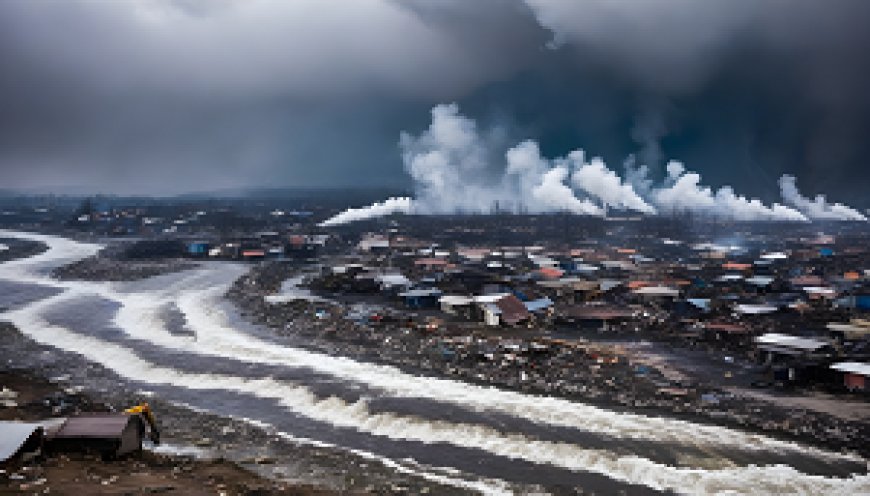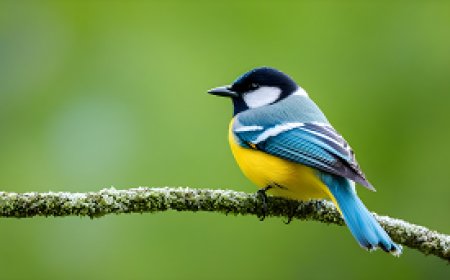A study on how to deal with diseases in environmental disasters
Environmental disasters represent significant challenges facing humanity in the modern era, causing substantial negati impacts on both the environment and human populations. The world is witnessing a noticeable increase in the occurrence of these disasters, whether resulting from natural phenomena such as earthquakes and floods or as a consequence of human activities such as environmental pollution and industrial disasters.

Environmental disasters represent significant challenges facing humanity in the modern era, causing substantial negati impacts on both the environment and human populations. The world is witnessing a noticeable increase in the occurrence of these disasters, whether resulting from natural phenomena such as earthquakes and floods or as a consequence of human activities such as environmental pollution and industrial disasters.
Among the challenges that arise in the context of these disasters is the issue of dealing with diseases resulting from these environmental incidents. Diseases and epidemics are serious health problems that may spread rapidly in the midst of the chaos and breakdown accompanying such emergency situations.
This study aims to explore and analyze how to handle diseases in the context of environmental disasters, as communities and health institutions must be prepared to effectively confront these challenges. Strategies for prevention and rapid response will be examined, along with an assessment of how coordination between different entities can be enhanced to improve the ability to address the spread of diseases in these challenging environmental conditions.
This study represents a step towards a better understanding of the increasing health challenges in the context of environmental disasters and the development of effective strategies to combat emerging diseases. This research is part of our ongoing efforts to enhance health preparedness and response in the face of contemporary environmental challenges.
Effective Prevention Strategies in Dealing with Diseases during Environmental Disasters
-
Preventive Analysis:
- Environmental Assessment: Studying the impacts of environmental disasters and identifying potential factors for disease spread.
- Risk Analysis: Identifying potential health risks and assessing the probabilities of disease spread.
-
Development of Plans and Policies:
- Health Policy Establishment: Developing a policy framework that includes strategies and plans to address diseases in environmental emergencies.
- Response Planning: Creating effective action plans to outline the necessary measures in cases of disease spread.
-
Awareness and Education:
- Health Awareness: Launching awareness campaigns about disease prevention and precautionary measures.
- Community Education: Disseminating knowledge within the community on how to deal with environmental disasters to reduce disease spread.
-
Strengthening Healthcare Infrastructure:
- Health Facility Enhancement: Developing and improving hospitals and healthcare centers to enhance the capacity to handle health emergencies.
- Providing Medical Resources: Ensuring the availability of necessary medical tools and equipment to combat diseases in the face of disasters.
-
Coordination and Collaboration:
- Enhancing Coordination Among Entities: Achieving effective coordination between local governments, healthcare institutions, and humanitarian organizations.
- International Collaboration: Promoting collaboration with international organizations to exchange information and expertise in addressing diseases in environmental emergencies.
-
Scientific Research and Innovation:
- Modern Method Development: Utilizing modern techniques in medical research to analyze and combat diseases effectively.
- Innovation in Medical Technology: Supporting research and innovation in healthcare technology to improve the response to diseases in emergency environments.
These elements constitute a comprehensive set of strategies that can be adopted to ensure effective preparedness and response to diseases during environmental disasters.
Assessing the Capability to Combat Disease Spread in the Context of Environmental Disasters
Assessing the capacity to combat disease spread in the context of environmental disasters is a crucial and vital step in preparing for and responding to these emergency conditions. This assessment includes a set of elements that contribute to determining the effectiveness of health preparedness and the ability to combat the spread of diseases in the context of natural or human-induced environmental disasters. Here is a detailed breakdown of some key elements for evaluating this capacity:
-
Analysis of Current Environmental Health: Involves assessing the current state of environmental health in the relevant area, including air, water, and soil quality, as well as potential pollutants.
-
Evaluation of Health Structures and Facilities: Examines the readiness of health institutions and medical facilities to handle emergencies, including verifying the availability of necessary human, technological, and medical resources.
-
Historical Analysis of Previous Disasters: Requires examining experiences and lessons learned from previous environmental disasters, including a review of preparedness and response and identifying priorities for improvement.
-
Identification of Analytical and Technical Capabilities: Includes assessing the strength of analytical and technical capabilities in diagnosing and monitoring diseases, including the capacity of laboratories and medical devices.
-
Assessment of Coordination and Communication Systems: Involves examining the efficiency of coordination systems among relevant entities and effective communication to ensure the swift and efficient exchange of information.
-
Analysis of Health Policy and Guidance: Requires a review of current health policies and procedures to ensure an effective direction for response and addressing the spread of diseases.
-
Development of Response Plans: Involves assessing the efficiency of current plans to respond to health emergencies and enhancing them as needed.
This assessment contributes to identifying strengths and weaknesses in the ability to combat the spread of diseases during environmental disasters, enabling health institutions and governments to take effective actions to improve preparedness and response.
Analyzing Coordination between Healthcare Institutions and Communities in Environmental Emergency Situations
Coordinating efforts between health institutions and communities is vital for achieving an effective response to environmental emergencies. This analysis requires examining several aspects to ensure seamless and effective collaboration in addressing health challenges during these emergency situations. Here is a detailed breakdown of several key aspects in analyzing coordination between health institutions and communities in environmental emergencies:
-
Assessment of Organizational Strength and Structure: Involves examining the efficiency of organizational structures and guidance in health institutions and communities to ensure a clear understanding of roles and responsibilities.
-
Analysis of the Effectiveness of Communication Channels: Includes studying the effectiveness and efficiency of communication channels between health institutions and communities to ensure a smooth flow of vital information.
-
Evaluation of the Preparedness of Health Institutions: Encompasses assessing the readiness and capacity of health institutions to deal with emergencies and provide effective healthcare.
-
Study of Community Awareness Levels: Relates to examining the extent to which communities understand health challenges and how responsive they are to guidance and warnings.
-
Analysis of the Community's Capacity for Collaboration: Involves assessing the ability to coordinate and collaborate within communities to contribute to public health efforts.
-
Assessment of the Needs of Vulnerable Communities: Relates to identifying the needs of vulnerable groups within communities and how to provide suitable healthcare for them.
-
Analysis of the Effectiveness of Awareness Programs: Includes evaluating health awareness programs and their effectiveness in improving preparedness and response to diseases in environmental emergencies.
Analyzing coordination between health institutions and communities contributes to building mutual understanding and enhancing communication to address common health challenges. This strengthens the ability to collaborate effectively in environmental emergencies
The Impact of Environmental Disasters on Healthcare Systems and How to Enhance Them
Exposure to environmental disasters poses a significant challenge to healthcare systems, greatly impacting their ability to provide care and respond to health emergencies effectively. Environmental disasters have negative effects, including the destruction of healthcare infrastructure such as hospitals, clinics, and medical facilities, reducing the capacity to deliver healthcare services. Additionally, these disasters lead to an increased demand for healthcare services due to rising numbers of injuries and diseases, placing substantial pressure on medical resources. The complexity of existing health conditions is exacerbated, making their management more challenging due to weakened infrastructure.
Ways to Enhance Healthcare Systems in Environmental Emergencies:
-
Developing Emergency Response Plans: Prepare robust response plans that include strategies to meet immediate healthcare needs.
-
Improving Healthcare Infrastructure: Enhance hospitals and clinics to withstand harsh environmental conditions and bolster the capacity to provide services.
-
Training and Qualifying Medical Teams: Provide ongoing training for medical teams to handle emergency situations effectively.
-
Enhancing Communication and Coordination: Improve communication between healthcare institutions, government entities, and communities to achieve effective coordination.
-
Developing Awareness Programs: Launch awareness campaigns for communities to promote awareness of disease prevention and disaster preparedness.
-
Responding to Emerging Health Issues: Formulate a rapid response to emerging health issues resulting from environmental disasters.
By adopting multidimensional strategies, healthcare systems can be strengthened to address the challenges of environmental disasters, ensuring the delivery of effective healthcare in these emergency conditions
Improving Health Policies to Address Diseases in Emergency Environmental Conditions
Enhancing health policies is essential to tackle health challenges arising from environmental emergencies. This necessitates the development of a legal and policy framework that reflects the community's needs in responding to diseases and health impacts resulting from environmental disasters. Here is a detailed overview of how to improve health policies to address diseases in environmental emergencies:
-
Assessment of Current Health Situation: Involves evaluating the current health situation in the area affected by environmental emergencies, including identifying prevalent diseases and immediate health needs.
-
Analysis of Current Policies: Includes examining existing health policies to ensure they align with the needs of addressing diseases in the context of environmental emergencies.
-
Development of Evidence-Based Legal Framework: Involves developing a legal framework based on scientific evidence to enhance effective and research-backed health decision-making.
-
Promotion of Prevention and Guidance: Encompasses promoting health prevention programs and guiding communities on how to avoid diseases in emergency environmental conditions.
-
Integration of Mental and Social Care: Involves developing policies that integrate mental and social care to support individuals affected by poor mental health due to environmental disasters.
-
Enhancement of Financing and Crisis Management: Involves improving healthcare financing systems and preparing crisis management plans to efficiently allocate resources during emergencies.
-
Encouragement of Research and Innovation: Includes supporting scientific research and encouraging innovation in healthcare to enhance understanding and management of diseases.
-
Achieving Coordination with International Entities: Involves promoting collaboration and achieving coordination with international organizations to address global health challenges.
Improving health policies is a crucial investment to ensure an effective and sustainable impact in addressing diseases in the context of environmental emergencies, safeguarding the health of communities.
Communication Technology and its Role in Improving Healthcare Response in Environmental Disasters
Telecommunications technology is a critical element in enhancing healthcare response during environmental disasters. Modern technologies in this field offer innovative opportunities to improve communication, coordination, and the delivery of effective care. Here is a detailed overview of how telecommunications technology impacts and enhances healthcare response during environmental disasters:
-
Instant Communication and Coordination: Providing instant communication means that enable healthcare teams and administrative bodies to interact and coordinate immediately for emergency care.
-
Remote Analysis and Guidance Systems: Using remote analysis techniques to assess the scale of disasters and guide resources and teams effectively.
-
Electronic Health Records: Improving access to electronic patient records to ensure continuous care and communication among medical teams.
-
Remote Healthcare Services Delivery: Enabling the delivery of healthcare remotely, reducing the need to transport patients in emergency conditions.
-
Tracking Medical Resources: Using tracking systems for medical resources to ensure their efficient distribution according to the needs of affected areas.
-
Social Media Platforms: Leveraging social media platforms to disseminate health guidelines and provide reliable information to the public.
-
Integration of Geographic Information Systems (GIS): Using GIS to understand affected locations, analyze spatial data, and identify points of immediate need.
-
Innovation in Medical Technology: Supporting innovation in healthcare technology to improve the diagnosis and treatment of emergency cases.
-
Online Training and Remote Learning: Providing platforms for training healthcare teams and disaster specialists online.
These technologies come together to enhance the healthcare system's ability to adapt and respond in the context of environmental disasters, improving the effectiveness of healthcare service delivery in emergency conditions.
Strengthening Human Capacities to Confront Health Challenges in Environmental Emergencies
Strengthening human capacities in the context of environmental disasters is crucial to improving response and enhancing effectiveness in addressing health challenges. This involves developing individual skills and boosting collective abilities to deal with challenging conditions. Here is a detailed overview of how to strengthen human capacities to address health challenges in environmental emergencies:
-
Medical and Nursing Skills Development: Providing continuous training for medical and nursing staff to enhance their skills in dealing with emergency cases and providing immediate care.
-
Promoting First Aid Training: Offering first aid training to the community to empower individuals to provide initial support until medical teams arrive.
-
Improving Crisis Management and Coordination: Directing training towards a better understanding of crisis management and enhancing coordination among different teams involved in the response.
-
Developing Psychological Capacities: Providing psychological and social support for medical teams and those affected to cope with work pressures and psychological challenges.
-
Enhancing Effective Communication: Focusing training on enhancing communication skills to ensure effective information exchange and smooth coordination.
-
Activating Community Participation: Encouraging community participation in training and providing knowledge to empower individuals in facing health challenges.
-
Providing Health Awareness Courses: Organizing health awareness courses for communities to promote awareness of disease prevention and effective response.
-
Integrating Technology in Training: Utilizing technology to improve training processes and providing virtual environments for hands-on learning experiences.
-
Promoting Motivation and Team Spirit: Organizing motivational events and fostering team spirit to ensure effective collaboration in facing environmental challenges.
-
Developing the Ability for Quick Decision-Making: Training medical teams to make quick and effective decisions in emergency conditions.
By enhancing these human capacities, readiness and response of healthcare teams and communities can be improved in facing health challenges arising from environmental disasters.
Analyzing the Effectiveness of Health Awareness Strategies During Environmental Disasters
Directing efforts toward understanding the effectiveness of health awareness strategies during environmental disasters is a crucial aspect of enhancing health response and disease prevention. This detailed analysis involves several aspects to measure and evaluate the effectiveness of these strategies:
-
Target Audience Analysis: Examining the characteristics of the target audience, such as age, cultural background, and education level, to ensure messages and guidance align with audience needs.
-
Information Content Evaluation: Reviewing the accuracy and consistency of information presented in awareness strategies to ensure the delivery of quality and reliable content.
-
Measuring Message Impact: Requires assessing the impact of awareness messages on improving knowledge and changing health-related behaviors among the audience.
-
Assessing Communication Channels: Involves evaluating the effectiveness of communication channels used, such as social media, advertisements, workshops, to determine the most effective medium.
-
Studying the Impact of Culture and Language: Entails understanding how culture and language may influence the comprehension and understanding of health messages and how to better adapt them to the audience.
-
Monitoring Interaction and Participation: Includes assessing the extent of audience interaction and participation in awareness strategies, aiding in measuring effective impact.
-
Analysis of Information Access Channels: Involves examining how the public accesses health information and analyzing the effectiveness of the channels used.
-
Evaluation of Social Interaction Strategies: Requires studying the impact of social interaction strategies in spreading awareness and encouraging positive engagement.
-
Analysis of Environmental Impact: Relates to examining how environmental conditions, such as the spread of environmental disasters, influence the public's response to awareness strategies.
-
Measuring Adaptability Capacity:
- Involves assessing the audience's capacity to adapt to information and health guidance during environmental disasters.
Through this comprehensive analysis, the effectiveness of health awareness strategies can be determined and improved to meet the needs of the public in the context of environmental disasters.
Developing Monitoring and Evaluation Systems to Combat Disease Spread in Emergency Environments
The development of monitoring and assessment systems is crucial in combating the spread of diseases in emergency environments, playing a pivotal role in rapid response and effective decision-making. This development encompasses several critical aspects:
-
Designing Effective Monitoring Systems: Includes improving the design of monitoring systems to be accurate and effective in collecting relevant health data during emergencies.
-
Utilizing Modern Technology: Involves adopting the latest technologies, such as Geographic Information Systems (GIS) and big data analysis, to enhance monitoring accuracy and understand the geographic distribution of disease spread.
-
Integrating Early Warning Systems: Focuses on integrating early warning systems to detect any rise in disease cases early on and take preventive actions.
-
Developing Biological Analysis Methods: Involves enhancing biological analysis methods to swiftly detect diseases and efficiently examine samples.
-
Healthcare Staff Training: Includes developing training programs for healthcare staff in using and maintaining monitoring systems to maximize their benefits.
-
Organizing Regular Assessments: Involves a periodic schedule to assess the performance of monitoring and assessment systems and updating them to suit the needs of new emergency environmental situations.
-
Promoting International Collaboration: Includes enhancing international collaboration to exchange information and expertise in the development of monitoring and assessment systems.
-
Ensuring Confidentiality and Security: Focuses on reinforcing security and confidentiality measures to protect health data and ensure its safe use.
-
Integration with Healthcare Systems: Relates to improving integration between monitoring and assessment systems and existing healthcare systems to achieve a consistent flow of information.
-
Adopting a Collaborative Approach with the Public: Involves activating the public's role in monitoring and assessment operations to improve the quality of available data.
Through the development of monitoring and assessment systems, the ability to respond to disease spread in emergency conditions is enhanced, allowing for effective decision-making to protect public health
Integrating Scientific Research and Innovation in Dealing with Health Challenges in Environmental Disasters
Technological advancements in healthcare and scientific innovation are crucial elements in enhancing a community's ability to address health challenges arising from environmental disasters. Effectively tackling these challenges requires the integration of scientific research and innovation in the context of environmental disasters, encompassing the following points:
-
Development of Medical Technologies: Involves using scientific research to develop advanced medical technologies, such as modern diagnostic methods and advanced medical technology.
-
Genomic and Molecular Analysis: Encompasses research in genomic and molecular analysis to better understand diseases and develop effective treatment methods.
-
Medical Communication Technologies: Supports research in developing remote medical communication technologies and online diagnosis to provide care in emergency conditions.
-
Data Analytics and Artificial Intelligence: Includes using data analytics and artificial intelligence to understand large medical datasets, identify trends, and make predictions.
-
Research in Vaccines and Treatments: Contributes to the development of effective vaccines and innovative treatments for diseases arising from environmental disasters.
-
Integration of Healthcare and Information Technology: Supports the integration between healthcare systems and information technology to improve the management of medical information and streamline administrative processes.
-
Enhancement of Field Diagnosis Methods: Involves innovation in field diagnosis methods to enable rapid and effective examination in emergency environments.
-
Investment in Research on Health Behavior: Involves investing in research on health behavior to identify the best ways to promote health awareness and change behaviors in emergency situations.
-
Verification of Health Policy Effectiveness: Supports research in assessing the effectiveness of health policies and adapting them based on the actual challenges in disaster situations.
-
Promotion of Medical Education and Training: Includes promoting medical education and training to ensure the availability of trained medical personnel to deal with the unique challenges of environmental disasters.
Through the integration of scientific research and innovation, the response to health challenges in the context of environmental disasters can be improved, leading to effective solutions for enhancing healthcare and prevention.
Enhancing International Collaboration to Improve Countries' Capacity to Combat Diseases in Environmental Emergencies
In the context of environmental disasters, effectively addressing diseases requires strong integration and international collaboration to enhance the ability for a rapid and efficient response. This collaboration includes several aspects that contribute to improving preparedness and response to diseases in environmental emergencies:
-
Exchange of Information and Expertise: Involves enhancing the exchange of information between affected countries and the international community to improve coordination and better understand health challenges.
-
Establishment of Collaboration Platforms: Includes creating international platforms for collaboration dedicated to addressing diseases in emergency conditions, exchanging experiences, and sharing best practices.
-
Encouragement of Scientific Collaboration and Research: Involves promoting collaboration in scientific research to better understand diseases and develop effective solutions.
-
Provision of Technical and Specialized Support: Includes providing technical and specialized support to countries in need of assistance in building health capacities.
-
Provision of Humanitarian Aid: Encompasses providing humanitarian aid in environmental emergencies, such as sending medical teams and supplying medical necessities.
-
Improvement of Joint Planning and Response: Involves developing joint plans to deal with environmental emergencies and enhancing countries' responses in a coordinated manner.
-
Development of Health Infrastructure: Includes supporting the development of health infrastructure in affected countries to enable them to better cope with diseases.
-
Enhancement of Training and Education Capacity: Involves strengthening the capacity for training and educating healthcare personnel to improve responses in emergency situations.
-
Global Integration of Health Policies: Supports the global integration of health policies to achieve better coordination in addressing global health challenges.
-
Interaction with Humanitarian Institutions: Involves interacting with humanitarian institutions and non-governmental organizations to enhance collaboration in providing assistance and support.
Through this international collaboration, the ability to address diseases in environmental emergencies can be enhanced, improving the effectiveness of the global response to these health challenges.
Summary
This study aims to examine and analyze how to deal with diseases in the context of environmental disasters, which pose significant challenges to public health and the environment. It highlights the urgent need to develop effective strategies to address the spread of diseases resulting from these emergency incidents, whether caused by natural or human-induced factors.
The study focuses on prevention and rapid response strategies and how to enhance coordination among various entities, including communities and healthcare institutions, to ensure effective preparedness and response to disease outbreaks in the face of environmental disasters. It also sheds light on evaluating current plans and policies and how to improve them to secure the health of individuals and communities in such challenging conditions.
This study is part of ongoing efforts to understand the increasing health challenges in the context of environmental disasters and to promote sustainable development of policies and procedures aimed at enhancing effective preparedness and response to diseases in such emergency situations.
What's Your Reaction?




















































































































































